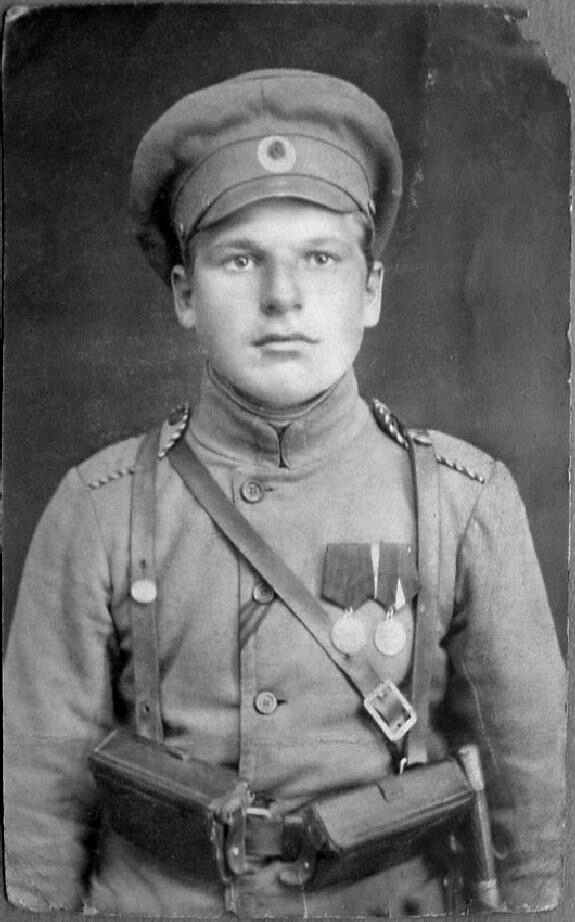
World War I: British Boy and Youth Volunteers

Figure 1.--Here we see a youthful World War I soldier. We thought he was British. The cap, however, does not seem just right. One reader thought he was wearing a St. George Ribbon and two medals. Another reader reports the Feorge medal was a Wofrld War I award. Unfortunately we do not his name or just why he was awarded the medals, but suspect he performed heroically. Also notice the saber and cartridge holsters on his belt. The portrait is not dated, but we believe was taken about 1916, perhaps earlier. Also note the braid on his epaulets. I'm not sure what that meant. He looks to be about 17 years old which mean that he enlisted earlier.
|
Here we see a youthful World War I soldier. We thought he was British. The cap, however, does not seem just right. Nor does the collar. And there are no pockets on the jacket. One reader thought he was wearing a St. George Ribbon and two medals. Another reader reports the Feorge medal was a Wofrld War I award. Unfortunately we do not his name or just why he was awarded the medals, but suspect he performed heroically. Also notice the saber and cartridge holsters on his belt. The portrait is not dated, but we believe was taken about 1916, perhaps earlier. Also note the braid on his epaulets. I'm not sure what that meant. He looks to be about 17 years old which mean that he enlisted earlier.
A reader writes, " have just looked at the photograph that accompanies the above item, and I do not believe this is a British uniform. The two points in particular, which make me uneasy are; (a) the medals which are not hung in the British fashion, in fact they look like russian or soviet style mountings, and (b) the leather waist pouches do not look British either. The George Cross and George Medal were not instituted until 1940 by King George VI, and is worn on the chest as other medals, and not through the uniform jacket front. (That seems to be a German style, though there may be others as well). The Cap Badge is not one of the British Regiments, and normally School Cadet forces are linked to a Regiment, and wear their badges; this circular style badge again smacks of Germanic origins to me, though the cut of the uniform is similar to British Uniforms of that time (or for that matter U.S. 'Doughboys').
We still have Cadet Forces over here. The CCF (Combined Cadet Force) is run in Public Schools (Schools which you pay to attend, such as Eton and Harrow) and then there are the ATC (Air Training Corps) sponsored by the RAF, the ACC (Army Cadet Corps) sponsored by the Army, and the Sea Cadet Corps sponsored by the Royal Navy. These organisations take young people from 12 to 18 years, though some have junior sections, and are run in the evenings and week-ends by Adult Volunteers, most of whom are registered as Reservists with the appropriate Military Force. The CCF recruits its leaders from amongst its teaching staff mostly, and are again registered as Reservists. All these cadet forces are supported by at Reginal and National level by staff seconded from the Military, and receive quite significant sums of money and material support, such as uniforms etc."
HBC

Navigate the Boys' Historical Clothing Web Site:
[Return to Main British age and conscription page]
[Return to Main World War I British youth volunteers page]
[Return to Main World War I age of soldiers page]
[Return to Main English cadet page]
[Introduction]
[Activities]
[Biographies]
[Chronology]
[Clothing styles]
[Countries]
[Bibliographies]
[Contributions]
[Essays]
[FAQs]
[Glossaries]
[Satellites]
[Tools]
[Boys' Clothing Home]
Created: 12:46 PM 12/12/2006
Last updated: 12:46 PM 12/12/2006



